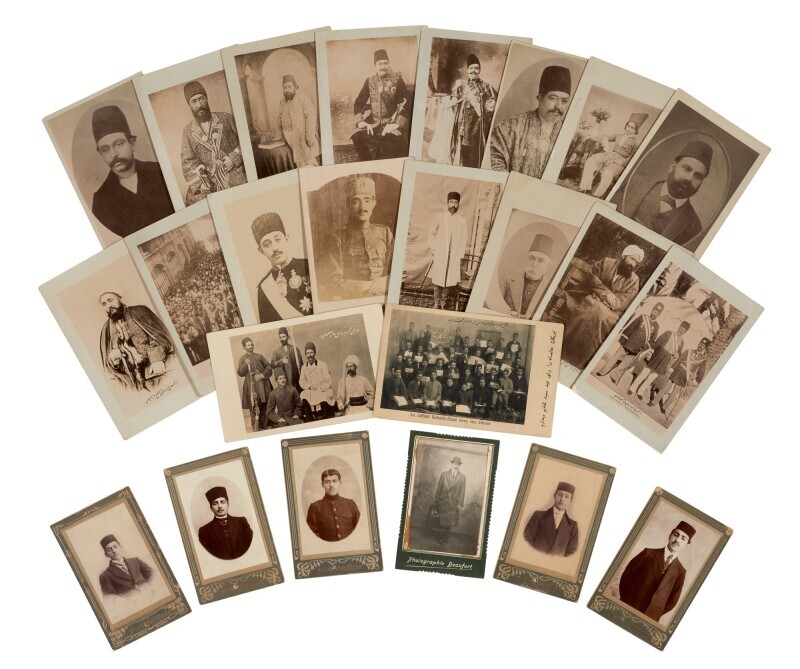I n an extremely rare offering, Sotheby’s is presenting an exceptional collection of Qajar photographs that provide the most comprehensive glimpse of Persia on the cusp of modernisation - at the end of a dynasty whose demise would usher in Iran as we know it today. The rose and the nightingale were soon to give way to oil rigs and the market economy, which would go on to transform the country.

Nineteenth century Persia was often the stuff of fantasy and Oriental exoticism to the West. Travellers’ accounts spoke of languishing Odalisque-style women, cloistered in harems ruled over by omnipotent feudal lords or tribal khans. Today, living as we do in an era of cultural re-appropriation, collections of early photographs taken by local, not foreign, photographers, carry a particular historical significance and value. They portray a more truthful image of those times, and are appreciated not just by the cognoscenti, museums, or even photography buffs, but also (and especially) by the native culture.
Notwithstanding Western influences, or the artifice of cabinet portraits, when photography first arrived in 19th century Persia, it allowed the Orientalist gaze to be reinterpreted. For once it became possible to have records of real life, real subjects and authentic settings – not designed to exoticize or titillate but represented truthfully.

The beginnings of photography in Iran appear to come straight out of an Oriental tale, with daguerreotype cameras arriving in 1842, on a horse-drawn carriage from Russia as a gift from the Czar. Amongst the first subjects to be photographed was Nasir al Din Shah, the then Crown Prince, who later himself became an enthusiast and the eye behind many a valuable photograph. A darkroom was soon established in an inner sanctum of the royal palace, where eunuchs were trained to print the Shah’s (sometimes nude) photographs of his wives.

Once newspapers appeared, photographs were regularly used as sources of illustration. Students of the country’s first modern college, the Dar al Fonun, were enlisted by the court to undertake photographic documentation across the nation, collaborating with the government press. Over time, the Dar al Fonun’s photographic studio, patronised by extended royal family members, wealthy courtiers, army chiefs and merchants, became the leading source of Qajar photographs. Eventually, commercial studios were established throughout the country, even though photography remained an elite occupation, with portraiture as the dominant genre. This early trend for photography has resulted in an exceptionally impressive and unique legacy. With Iran being off the beaten track for most 19th century European artists heading to the Levant, it lacks a body of detailed, scenic historical paintings as found in Egypt, for example. But these precious photographs provide a documentary record that stands for itself.

Within this collection lies a vast span of subject matter, covering a geography from Persia and Afghanistan across to Iraq, and sweeping outwards from the Caucasus to the wider region, taken between the 1860s to the 1920s. With upwards of 4,000 photographs (of which around 3,500 are portraits and assorted views of Persia), ranging in size from cartes-de-visite and cabinet cards to large format mounted prints, the full collection takes up approximately 50 albums and folders, four 3-drawer cabinets and three boxes.

Aside from the Shah’s portraits and royal scenes, we see fascinating images of women in a variety of poses and dress. Some are nude, wearing angel wings (referring to the ‘houri of paradise’). Then there are the opium smokers, chess players, pahlavans or ‘strong men’, executions by hanging, the spice bazaar, Isfahan’s Chehel Sotun, fishermen, military groups, camel riders and medical students. The range of subject matter is staggering and the eager, studied poses of the subjects bring to mind today’s trend for Instagramming – the compulsion to thoroughly document oneself.
‘This is the largest and most important single collection of Qajar photographs of Persia ever to appear at auction’
‘This is the largest and most important single collection of Qajar photographs of Persia ever to appear at auction,’ says Sotheby’s Senior Specialist (Books & Manuscripts) Richard Fattorini, ‘and one of the greatest photographic archives of Qajar Persia outside of the Golestan Palace. The collection includes original velvet-bound albums and was formed in the second half of the 20th century, never having been shown or exhibited before, offering the public a rare opportunity to view these extraordinary photographs for the first time.’

Both Queen Victoria and Prince Albert were advocates of photography, shrewdly aware of the importance of spreading their image around the world. Naser al-Din Shah, their contemporary and a visiting monarch, also asserted his status and power via the dissemination of his own portraits. With photographs by such well-known figures as Sevruguin and Agaiantz, the Qajar photography in this collection bears testimony to a surprisingly open spirit of disclosure, from inside a lesser-known and often-misunderstood culture.


